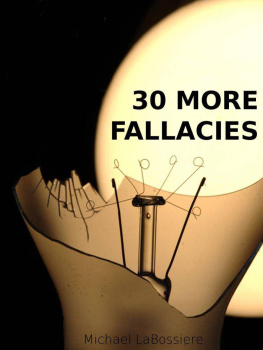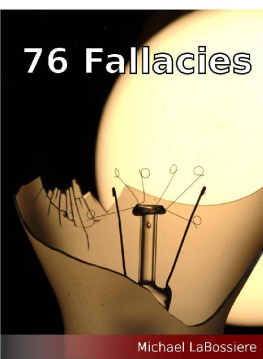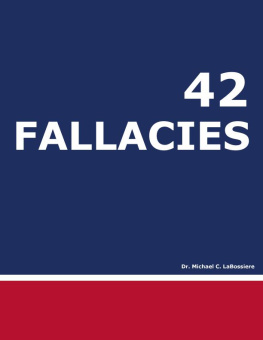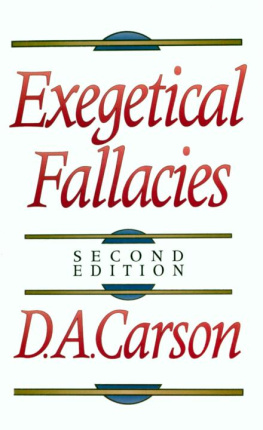Michael LaBossiere - 30 More Fallacies
Here you can read online Michael LaBossiere - 30 More Fallacies full text of the book (entire story) in english for free. Download pdf and epub, get meaning, cover and reviews about this ebook. year: 2011, genre: Romance novel. Description of the work, (preface) as well as reviews are available. Best literature library LitArk.com created for fans of good reading and offers a wide selection of genres:
Romance novel
Science fiction
Adventure
Detective
Science
History
Home and family
Prose
Art
Politics
Computer
Non-fiction
Religion
Business
Children
Humor
Choose a favorite category and find really read worthwhile books. Enjoy immersion in the world of imagination, feel the emotions of the characters or learn something new for yourself, make an fascinating discovery.
- Book:30 More Fallacies
- Author:
- Genre:
- Year:2011
- Rating:5 / 5
- Favourites:Add to favourites
- Your mark:
- 100
- 1
- 2
- 3
- 4
- 5
30 More Fallacies: summary, description and annotation
We offer to read an annotation, description, summary or preface (depends on what the author of the book "30 More Fallacies" wrote himself). If you haven't found the necessary information about the book — write in the comments, we will try to find it.
30 More Fallacies — read online for free the complete book (whole text) full work
Below is the text of the book, divided by pages. System saving the place of the last page read, allows you to conveniently read the book "30 More Fallacies" online for free, without having to search again every time where you left off. Put a bookmark, and you can go to the page where you finished reading at any time.
Font size:
Interval:
Bookmark:
30 More Fallacies
1st Edition
Michael C. LaBossiere
This book is copyright 2009-2011 by Dr. Michael C. LaBossiere ,
All rights reserved. No part of this book may be reproduced, in any form or by any means, without permission from the author.
Broken bulb photo by Bern Liebers ( stock.xchng : http://www.sxc.hu/profile/Bernd89 )
Introduction
Examples
The Fallacies
Accent, Fallacy of
Accident, Fallacy of
Amphiboly, Fallacy of
Appeal to Envy
Appeal to Group Identity
Appeal to Guilt
Appeal to Silence
Appeal to Vanity/Elitism
Argumentum ad Hitlerum
Complex Question
Confusing Explanations and Excuses
Cum Hoc, Ergo Propter Hoc
Equivocation, Fallacy of
Fallacious Example
Fallacy Fallacy
Historians Fallacy
Illicit Conversion
Incomplete Evidence
Moving the Goal Posts
Oversimplified Cause
Overconfident Inference from Unknown Statistics
Pathetic Fallacy
Positive Ad Hominem
Proving X, Concluding Y
Psychologist's fallacy
Rationalization
Reification, Fallacy of
Texas Sharpshooter Fallacy
Victim Fallacy
Weak Analogy
This book is intended as a companion to my 42 Fallacies and it adds thirty fallacies. However, this book does not require that you have 42 Fallacies and it stands on its own.
As the title indicates, this book presents thirty fallacies. Understanding what a fallacy is requires that you first have at least a basic understanding of arguments in the philosophical sense. In philosophy, an argument is not a fight or even a dispute. Rather, an argument is as set of claims (statements that can be true or false) that are related in a way that one of them is supported by the others. Another way to look at it is that one claim is presented to be proven and the other claims are presented as evidence or reasons for that claim,
In technical terms, the claim being argued for is known as the conclusion. A single argument has one (and only one) conclusion. One way to spot a conclusion is to ask what is the point that is supposed to be proven here? If there is no point, then there is no argument. Of course, a person can make a point without offering proof, so what is also needed is evidence or reasons. The evidence or reasons being presented in support of the conclusion are known as premises. An argument will always have at least one premise, but there is no limit on the number allowed. One way to find premises is to ask what reasons, if any, are being given in support of the conclusion? If no reasons are given, then there is no argument present.
In general, philosophers take arguments to be of two main types: deductive and inductive. A deductive argument is an argument such that the premises provide (or are supposed to provide) complete support for the conclusion. An inductive argument is an argument such that the premises provide (or are supposed to provide) some degree of support (but less than complete support) for the conclusion. The support given by the premises to the conclusion is a matter of logic and, interestingly enough, has nothing to do with whether the premises are actually true or not. I will say more about this later.
If a deductive arguments premises properly support the conclusion, the argument is valid. In technical terms, a valid deductive argument is such that if all its premises were true, then its conclusion must be true.
If a deductive argument is valid and actually does have all true premises, then it is sound. An argument can be valid and unsound by having one or more false premises.
If a deductive argument is such that the premises could all be true while the conclusion is false at the same time, then the argument is invalid. Invalid arguments are always unsound. This is because a sound argument must be valid and have all true premises.
An invalid argument is also known as a formal fallacy or a deductive fallacy. This book does not cover these fallacies.
Deductive arguments are tested for validity using a variety of methods, such as Venn diagrams, truth tables and logical proofs. While these are interesting (well, to some people), they will not be covered in this book.
Inductive arguments are assessed differently from deductive arguments. If the premises of an inductive argument support the conclusion adequately (or better) it is a strong argument. It is such that if the premises are true, the conclusion is likely to be true. If a strong inductive argument has all true premises, it is sometimes referred to as being cogent.
One feature of inductive logic is that even a strong inductive argument can have a false conclusion even when all the premises are true. This is because of what is known as the inductive leap: with an inductive argument the conclusion always goes beyond the premises. However, this does not make all inductive reasoning fallacious (although it does make it all technically invalid). An inductive fallacy occurs when an arguments premises do not adequately support the conclusion. In most fallacies this occurs because the premises being offered have little or no logical connection to conclusion. The fallacies covered in this book are of the informal inductive sort.
Before moving on to the actual fallacies, it is necessary to have a short discussion about what fallacies are not. Unfortunately for those who teach about fallacies, people often use the term fallacy when they are actually referring to a factual error. For example, someone might say a lot of people think that Google created Android from scratch, but that is a fallacy. Google actually based Android on Linux. While thinking that Android was created from scratch would be an error, it is an error about the facts, rather than an error in logic. If someone said Android is awful. After all, a fair number of creepy geeks use it, then this would be an error in logic. Even if creepy geeks use Android, this does not prove that the operating system is awful. While both of these are mistakes, they are two different types of mistakes.
To see why, think about balancing a checkbook. I can make a mistake by doing the math incorrectly (which would be an error in reasoning) and I can make a mistake by entering the wrong amount for a check. These errors are different and treating them the same would cause confusion. The same applies for fallacies and factual errors.
To use another analogy, think about cooking. One way I could screw up a meal is by cooking badly. This would be like an error in logic. Another way is that I could use the wrong (or bad) ingredients. That would be like making a factual error.
As such, it is one thing to get the facts wrong (factual error) and quite another to reason badly about them (fallacy).
So, a fallacy is an error in reasoning/logic. To be more specific, a fallacy is an argument in which the premises fail to provide adequate logical support for the conclusion. A deductive fallacy, as noted above, is a deductive argument that is invalid (it is such that it could have all true premises and still have a false conclusion). Whether an argument is valid or invalid is an objective matter and can be tested by various means, such as truth tables and proofs.
An inductive fallacy is less formal than a deductive fallacy. They are weak inductive arguments in which the premises do not provided enough support for the conclusion. While deductive arguments can be tested with objective and definitive means, the same is not true for inductive arguments. There are objective standards, but assessing informal fallacies is somewhat like judging figure skating: really good and really bad cases are easy to spot, but there are situations where there will be reasonable dispute.
People also use the term fallacy to refer to errors that are not factual errors and do not involve actual arguments (in the technical sense). This is sometimes done when referring to cases of rhetoric in which an argument is not present. Some people are rather flexible about what counts as a fallacy and include things that more strict classifiers would exclude. My approach is to present the fallacies in terms of being flawed arguments while also respecting the broader usage of the term by mentioning such common uses in the relevant fallacies.
Font size:
Interval:
Bookmark:
Similar books «30 More Fallacies»
Look at similar books to 30 More Fallacies. We have selected literature similar in name and meaning in the hope of providing readers with more options to find new, interesting, not yet read works.
Discussion, reviews of the book 30 More Fallacies and just readers' own opinions. Leave your comments, write what you think about the work, its meaning or the main characters. Specify what exactly you liked and what you didn't like, and why you think so.










